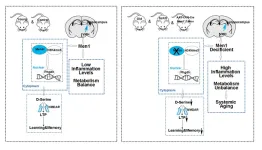(Press-News.org) ITHACA, N.Y. -- A novel cancer therapeutic, combining antibody fragments with molecularly engineered nanoparticles, permanently eradicated gastric cancer in treated mice, a multi-institutional team of researchers found.
The results of the “hit and run” drug delivery system, published in the March issue of Advanced Therapeutics, were the culmination of more than five years of collaboration between Cornell, the Memorial Sloan Kettering Cancer Center (MSKCC) and biopharmaceutical company AstraZeneca.
“I’ve seen beautiful results before, but I’ve never seen something that eradicates a tumor like this,” said study co-lead author Dr. Michelle Bradbury, MSKCC director of intraoperative imaging and professor of radiology at Weill Cornell Medicine.
The other co-lead authors are Ulrich Wiesner, the Spencer T. Olin Professor in the Department of Materials Science and Engineering, at Cornell Engineering; and J. Anand Subramony, vice president of protein engineering research and development at AstraZeneca at the time of the study.
Targeted cancer treatments such as antibody and nanoparticle therapies have seen narrow clinical use because of each therapy’s limitations, but the new therapeutic – an evolution of what the researchers call Cornell prime dots, or C’ dots – combines the best attributes of both into an ultrasmall, powerfully effective system.
As silica nanoparticles just 6 nanometers in size, C’ dots are small enough to penetrate tumors and safely pass through organs once injected into the body. Wiesner first developed them more than 15 years ago and, in collaboration with Bradbury, published a 2018 study that found an antibody fragment-nanoparticle hybrid to be especially effective in finding tumors.
This collaborative work with AstraZeneca set off the search for a new, molecularly engineered therapeutic version of this immuno-conjugate.
AstraZeneca “site engineered” fragments of antibodies so they would effectively attach to the C’ dots and target HER2 proteins associated with gastric cancer. The team optimized fragment conjugation to the C’ dot surface, along with specialized inhibitor drugs developed by AstraZeneca. This enabled the nanoparticles to carry about five times more drugs than most antibodies.
The final product was a version of C’ dots, armed with cancer-targeting antibody fragments and a large drug payload, all packed into a sub-7-nanometer, drug-immune conjugate therapy – a first of its kind in that size class, according to the researchers.
“We describe the mode of action as ‘hit and run,’” Wiesner said, “because the C’ dots either target the tumor microenvironment and kill the tumor cells or get safely cleared out of the body via renal clearance as a result of their small size, thereby minimizing off-target accumulation and associated side effects and toxicity.”
Mice with gastric cancer received three doses of the therapeutic. Not only did the treatment eradicate the disease in every mouse, but there was no evidence of tumor recurrence after nearly 200 days.
“Usually you’d have to couple the treatment with other therapies to see those kind of long-term results,” Bradbury said. “It showed that the very detailed, careful work of this team – the years spent on the stoichiometry and the surface chemical developments – it paid off.”
Bradbury underscored the versatility of the C’ dots platform, and said she envisions it being used not as a replacement for antibody treatments, but as a complementary tool that can be adapted to different types of cancers and other specific needs of patients.
“C’ dots have become unusually efficacious and safe in treating cancer. They completely obliterated the tumor, even at the cellular level,” said Wiesner. “This is what we ultimately had hoped for and it further supports our earlier decision to bet on therapeutic C’ dot applications.”
Wiesner and Bradbury said the research behind the new C’ dot therapeutic will be continued by Elucida Oncology, a startup company they founded to help bring the technology to market. They said that while Elucida is not using antibody fragments in their current clinical trial of C’ dots, the work will help them build new conjugates that can potentially utilize such fragments in future trials.
-30-
END
Antibody fragment-nanoparticle therapeutic eradicates cancer
2023-03-16
ELSE PRESS RELEASES FROM THIS DATE:
Childhood volunteering encourages future voting in elections, study shows
2023-03-16
Childhood volunteering encourages those from politically disengaged homes to go on and vote when they are older, a major new study shows.
Community action leads to them becoming more interested in politics and to see voting as a duty, according to the research.
However volunteering didn’t have the same impact for most children, so it shouldn’t be seen as the answer to falling voter numbers.
The research was carried out by Dr Stuart Fox, now at the University of Exeter and conducted while he worked at Brunel University. He used the United Kingdom Household Longitudinal Survey and structural equation modelling to examine ...
Extinct animals on islands cannot be replaced
2023-03-16
Lush plants, large trees and many different, beautiful and colorful exotic animals. This is probably how most people imagine the small island of Mauritius in the Indian Ocean.
But that may not be the case. As in several other places in the world, the island and its nature are at risk of mass extinction, and in just a decade or two the flourishing nature and the many diverse animals may have dwindled to very few.
At least if the extinction of the many plants and animals on the island continues. They are part of a particularly sensitive ...
DNA treatment could delay paralysis that strikes nearly all patients with ALS
2023-03-16
In virtually all persons with amyotrophic lateral sclerosis (ALS) and in up to half of all cases of Alzheimer’s disease (AD) and frontotemporal dementia, a protein called TDP-43 is lost from its normal location in the nucleus of the cell. In turn, this triggers the loss of stathmin-2, a protein crucial to regeneration of neurons and the maintenance of their connections to muscle fibers, essential to contraction and movement.
Writing in the March 16, 2023 issue of Science, a team of scientists, led by senior study author Don Cleveland, PhD, Distinguished Professor of Medicine, Neurosciences and Cellular and Molecular Medicine at University ...
Loss of Menin helps drive the aging process, and dietary supplement can reverse it in mice
2023-03-16
Decline in the hypothalamic Menin may play a key role in aging, according to a new study publishing March 16th in the open access journal PLOS Biology by Lige Leng of Xiamen University, Xiamen, China, and colleagues. The findings reveal a previously unknown driver of physiological aging, and suggest that supplementation with a simple amino acid may mitigate some age-related changes.
The hypothalamus has been recognized as a key mediator of physiological aging, through an increase in the process ...
Dana-Farber researchers chart a course for understanding, preventing, and treating young-onset colorectal cancer
2023-03-16
Colorectal cancer among young people is increasing globally and rapidly. Experts expect it to become the leading cause of cancer death in individuals aged 20-49 in the U.S. by the year 2030.
Yet no one is certain why this disease is suddenly affecting so many young people. In a new paper published in Science, Dana-Farber Cancer Institute researchers outline the complexities of the disease and the research needed to map out a path toward understanding it.
“The rising incidence of young-onset colorectal cancer is extremely concerning, and it is urgent that the scientific community comes together to better understand the underlying ...
Hidden signals play a vital role in evolution of warning coloration in amphibians
2023-03-16
New findings help answer a particularly vexing evolutionary question: how do species that use bright coloration to keep predators away survive long enough for this warning signal coloration to evolve, before predators who can better spot them through their colors learn to avoid them? A study comparing a series of models points to warning color signaling, or aposematism, likely appearing through intermediate steps where coloration is only visible when an organism is fleeing or intentionally displaying a hidden feature. Evolutionary selection to avoid being eaten by predators has driven considerable variation in the diversity of animal ...
Common gut bacterium exploits Rho factor phase separation to colonize the mammalian gut
2023-03-16
The common commensal gut bacterium Bacteroides thetaiotaomicron uses phase separation of the transcription termination factor Rho to colonize and thrive in the mammalian gut, according to a new study in mice. The findings suggest that phase separation may also be vital for other important gut microbes and relevant for novel microbiome-based clinical applications. The gut microbiota plays a critical role in human health. Manipulating gut commensal communities could provide promising therapeutic pathways for treating a host of diseases. However, this goal requires understanding mechanisms that enable ...
Lessons from China’s coal strategy can inform environmental cooperation
2023-03-16
In 2021, China unilaterally announced that it would stop building new coal-fueled power plants overseas, which was lauded as an important climate milestone. However, this decision stands in contrast to the nation’s continued support for the domestic use of coal plants. In a Policy Forum, Christoph Nedopil discusses this dichotomy and provides new insights into how these decisions were made. According to Nedopil, the findings could inform efforts to improve environmental cooperation with China. China has become the world’s greatest source of greenhouse gas emissions, and its international influence through trade, ...
Nano cut-and-sew: New method for chemically tailoring layered nanomaterials could open pathways to designing 2D materials on demand
2023-03-16
A new process that lets scientists chemically cut apart and stitch together nanoscopic layers of two-dimensional materials — like a tailor altering a suit — could be just the tool for designing the technology of a sustainable energy future. Researchers from Drexel University, China and Sweden, have developed a method for structurally splitting, editing and reconstituting layered materials, called MAX phases and MXenes, with the potential of producing new materials with very unusual compositions and exceptional properties.
A “chemical scissor” is a chemical designed to react with a specific compound to break ...
Fomepizole helps overcome antibiotic-resistant pneumonia in mice
2023-03-16
Pneumococcal disease leads to over three million hospitalizations and hundreds of thousands of deaths annually. A study publishing March 16th in the open access journal PLOS Biology by Carlos J. Orihuela at the University of Alabama at Birmingham, Alabama, United States, and colleagues suggests that the FDA-approved drug Fomepizole may reduce disease severity in the lungs of mice with some forms of bacterial pneumonia and enhance the efficacy of the antibiotic erythromycin as well.
Streptococcus pneumoniae is the leading cause of community-acquired ...


